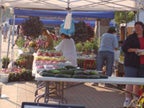What is Local Food, and How Should it be Defined?
My friend Jason Foscolo recently wrote an excellent blog post addressing the ambiguities inherent in the way that “local food” is defined. So what is local food, and what should it be?
One large “natural” food retailer has defined “local food” as having been produced within a few hundred miles of the warehouse to which it was delivered. But this company’s few centralized warehouses ship food to stores in a wide geographic area. Thus, their “local food” may have been produced 1000 miles from the store where it’s being sold. This is an extreme example, but if you are shopping at a large retail supermarket, even food produced on a farm next door to your house is often sent hundreds of miles to a warehouse near a major city, then shipped back to the store down the street.
In his post, Jason questions the use of the arbitrary distance measures (100 miles is a common one) by which “local” is typically defined. Equally dubious, in my opinion, are definitions of “local” based on regional boundaries. “Select Michigan”, a public advertizing campaign from the Department of Agriculture in my state was set up to “… [connect] consumers and companies with local businesses and growers”. Yet where I live (in Lansing) it’s a 14 hour drive to the western part of Michigan’s Upper Peninsula, whereas I can be in Ohio in just over an hour. Our largest city (Detroit) is not only closer to Ohio than it is to the main fruit and vegetable growing regions in the state, it is also less than a mile away from Canada. Is an apple “local” if it was grown 10 miles away, but in a different country?
The answer depends on what the definition of “local” is. And individual reasons for buying “local” may or may not actually be addressed by the definitions and labeling systems that are currently in practice. If the reason someone chooses to buy “local food” is related to supporting the economy of their own state/country, then the apple grown close-by in Canada doesn’t fit, though it certainly fits a definition of “local food” based on geographic distance. On the other hand, an apple produced many hundreds of miles north on the Wisconsin border may not fit typical definitions of “local food” but would accomplish the thing is important to the hypothetical consumer mentioned above.
For many consumers there also seems to be a notion that “local food” is synonymous with small farms. But geographic definitions simply don’t take this into account. Is it better to buy milk from the 10,000 cow confinement dairy 10 miles away, or from a cooperative of 50 small organic farms several states away? Again the answer depends on individual values, and what attributes people believe are important. If it’s about supporting the local economy, then it’s probably better to buy products produced on the nearby farm. But if it’s about supporting small farms or protecting the environment, then buying from the distant cooperative probably makes more sense.
Jason suggests that one way to deal with the ambiguities inherent in defining and labeling “local food” based on arbitrary geographic measures is to use a “social distance methodology” instead. He proposes that “‘local’ should define a relationship, an information loop between a producer who knows her customer and a customer who knows something about how the food is made”. Indeed, it seems that such a system (if it were implemented in a way that assured its integrity and provided sufficient information) would allow eaters to make purchasing decisions based on the attributes that are most important to them.
But how might consumers respond to such a definition? Would it simply be to complicated for many to process? How would it be implemented, and by whom? Could such a definition help to counter corporate co-opting of the “local food” that “local food advocates” say is threatening the movement? Is it threatening the movement (see The Corporate Co-Opt of Local, and McDonald’s Rings in 2012 with Farmwashing).
These questions will have different answers depending on who you ask. The issues remain contested, and Jason’s proposal remains largely untested. What does seem clear is that 1) bumper sticker-style slogans like “buy local food” are not particularly meaningful if local is not something that is well defined; 2) competing definitions of “local” abound, and many interpretations are rather dubious; 3) large corporations are increasingly using the “local” label (for better or worse) and this trend is likely to continue; and 4) definitions of “local” based simply on geography are arbitrary, often misleading, and don’t necessarily promote the things that are important to people who chose to “buy local food”.
If you would like to weigh in on this issue, please click on “comments” in the top left corner of this post (below the title).
– Taylor Reid



 Your Privacy Choices
Your Privacy Choices
One of my local grocers considers anything grown in the US to be local. Personally I use the 200 mile mark as local for me. In my area there is not a lot of local organic food available, so some places use the “region” as their mark which encompasses about 4-5 states… still better than Cali or Mexico I guess.
I agree with Jason’s take on local food. I believe one of the important goals of the local food movement should be reconnecting people with their farmers and food. So naturally its vital to have a relationship with the grower of your food, and understand how it was grown. Otherwise, if we simply base the definition of local on proximity, we may continue to support unsustainable agriculture and real change may not happen.